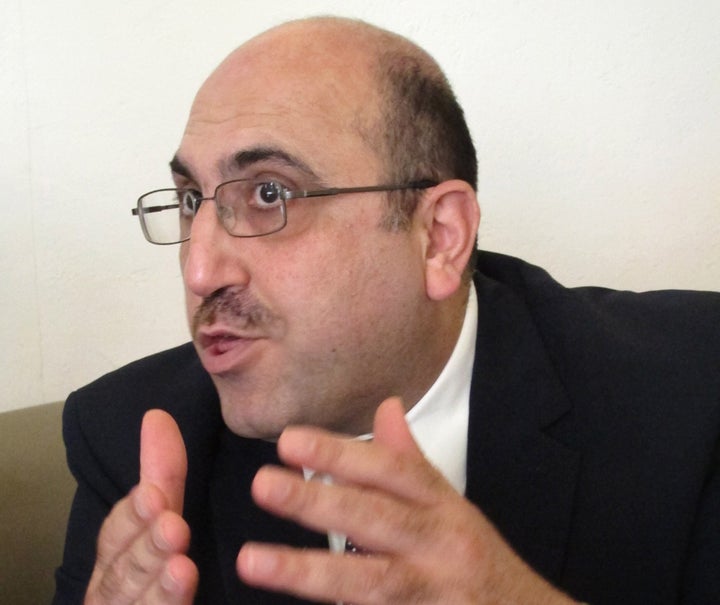
More than three years into Syria's devastating civil war, information about the harrowing costs of violence in the country is getting harder and harder to come by.
After a wave of killings and kidnappings, many international journalists, aid workers and diplomats have left the country. In January, the United Nations stopped regularly updating its casualty figures, citing lack of access on the ground.
Throughout the conflict, however, one Britain-based Syrian advocacy group has kept up a constant stream of reports from the battlefields.
The Syrian Observatory for Human Rights, a small network of activists and informants, is run by Rami Abdul Rahman, a Syrian human rights activist living in Britain.
His reports have become a crucial source of information on the war for many major news outlets and have been praised by groups like Amnesty International for their accuracy. Some Syrian groups accuse him of bias, but Abdul Rahman strongly defends his reputation for providing reliable information.
The WorldPost spoke to Abdul Rahman about his work, the impact of the coalition airstrikes, and the current situation in Syria.
Where does the Observatory get its information and how do you verify reports?
We work hard to get comprehensive information about what is happening on the ground in Syria. We have over 230 Syrians on the ground working with us and we communicate with them via phone, Skype, Facebook and WhatsApp. We never use information based on one source, but cross-verify. We are attacked by both sides. Nobody is happy with our work, because nobody wants the truth to come out. Our group doesn't have the whole truth, but we are very close.
What is your latest information about the number of civilian casualties and militant casualties of the U.S.-led coalition airstrikes in Syria?
So far, 904 people have been killed. Of them, 52 are civilians, including eight children and five women. Of the non-civilians killed, 72 are members of the Nusra Front and 779 members of ISIS. Coalition airstrikes also killed one fighter from a rival Islamic group who was being held prisoner by ISIS.
In what kind of incidents have coalition airstrikes killed civilians?
Some civilians died when the coalition attacked fighters of the Nusra Front who were located in a civilian area. Airstrikes on oil fields have killed civilian oil workers. However, most of the coalition airstrikes have targeted ISIS fighters outside of civilian areas, for example at checkpoints.
Could the death toll be higher than your figures?
The number of civilians is accurate -- we work incredibly hard to get those figures right.
We think the number of ISIS casualties is probably a few hundred more than what we have reported, since it's difficult to get information about those incidents. For example, some ISIS fighters who are wounded or killed are taken into Iraq, where it is difficult for us to record.
From the casualty figures, it appears the U.S.-led coalition is targeting ISIS much more than the Nusra Front/
Yes. The Nusra Front has been bombed in just a few locations, while ISIS has been targeted across the country.
How have activists and opposition fighters on the ground reacted to civilian casualties?
Everybody is angry. No one can accept any civilian being killed.
What is your latest information on the total number of casualties from the war in Syria since 2011?
To date, 197,378 people have been killed. Of them, 62,347 are civilians, including 6,468 women.
Of the non-civilians: 34,060 are rebel fighters, 21,343 are non-Syrian jihadis, 43,396 are regime forces, 2,381 are de-facto regime forces -- people who used to be in the army and are fighting for the regime -- 28,198 are from militias allied to the regime, 620 are Hezbollah, 2,075 are Shia militia supporting the regime, and 2,958 are unknown persons.
We think there are at least 80,000 more deaths than we have recorded, mostly of fighters. We are 99 percent certain that our civilian casualty figures are accurate.
Have you noticed an increase in Syrian government airstrikes since the coalition bombing campaign began? Has the number of casualties from these airstrikes gone up?
There have been more airstrikes since the coalition bombing campaign, but not more deaths. Most of the civilians have left these areas by now. For example in Aleppo, government shelling used to kill around 50 people each time, now it kills about 15 people each time.
Have you noticed any changes in casualty patterns over the years of Syria's war?
According to our figures, about 67,000 people were killed in Syria last year, while this year, 66,800 people have already been killed. So it appears that more people have died this year. Yet, the majority of those killed this year are not civilians but a greater number of rebel fighters and Syrian regime forces have been killed in clashes.
A significant different is that ISIS jointly-controlled just a few areas in Syria last year, whereas ISIS is now controlling around 40 percent of the country. This has led to more killings. Every time ISIS fighters capture a new area, they kill the rebel fighters there. From Jan. 3 until today, ISIS militants have killed more than 10,000 rebels. Kurdish fighters have also been killed in greater numbers this year. In addition, we found that ISIS killed around 1,000 soldiers fighting for the Syrian regime in just July and August of this year.
You have reported on several local cooperation agreements between ISIS and the Nusra Front in Syria. Is there a danger of them combining forces on a broader scale, or are these very local agreements?
I think these agreements will continue, although ISIS and the Nusra Front will deny it publicly. They hide their cooperation because the Nusra Front has some support among Syrians, but the Syrian people hate ISIS. The Nusra Front is clever and has played on sectarian tensions to get support, saying they defend Sunnis. By contrast, ISIS is hated because they have killed so many Syrians and beheaded people in the streets.
In reality, we don't see a big difference between the Nusra Front and ISIS. They share the same strategy to control Syria for jihadist aims and both are fighting against democracy. The difference is this: The Nusra Front says 'you are my brother', and then they kill you. ISIS will kill you face to face.
We have been warning about the growing jihadist groups since 2011, but no one was listening. When you cover something up, it will only continue.
This interview took place on Friday Nov. 21 and was edited and condensed for clarity.
CORRECTION: The story has been updated to correct the number of casualties tallied by the organization at the time of publication.

